22nd November Carnarvon Gorge
We leave Emerald and make the drive to Carnarvon Gorge driving along the A7 65km south to Springsure then another 70 km east to Rolleston along the Great Inland Way. From here it is a further 61km south to the Carnarvon turnoff. Plumes of smoke from bush fires appear on the horizon and we hope it is not another case of not being able to enter, considering we had just driven for miles to get here!
The last 25km is on a corrugated dirt track passing field after field. We spot a solitary massive white bird walking near the road and stop to take a closer look; it’s either a sarus crane or a brolga. The two species are similar. As I approach with the camera trying to take a photo, for every step I take the huge bird takes two. Eventually I get a photo but the bird now seems to be miles away!
Finally arriving at the fabulously named Takarakka Bush Resort, we pay for a site in the large open green field. The site is pretty quiet so are able take our pick of where to camp. In the area next to the camp kitchen are a group of kangaroos along with their joeys munching on the grass.
Amazingly, they let us come really close and do not seem scared by our presence at all. Although we actually try to stay clear of the larger ones, they move swiftly and are enormous!
The animals which we once thought were so elusive seem to be permanent residents in this wooded green sanctuary.
There are warnings of snakes, spiders and scorpions and to always use a torch at night. We are out in the bush after all! Luckily, we don’t see anything scarier than a few large frogs. We quickly set up camp as the light is about to fade. Suddenly, the birds seem to go crazy, wicked laughing noises coming from the treetops above our tent! The rain abruptly starts and the tent starts to leak in places, we just hope it will hold up for the rest of the night or we will be sleeping in the car! Maybe a cabin would have been a better idea….
23rd November
The rain did not seem to let up last night and the morning brings another torrent, but fortunately the tent had stopped leaking.
Martin wakes up early (6am) and heads to the rangers office to find out if the tracks are open and also the latest weather forecast. On route all the kangaroos are out in the rain;
he spots two having a fight, standing on their hind legs just like two boxers in a ring!
We are one of just a handful of people left in the park, most seem to have left this morning. We think we will have to wait out the day and take the walk tomorrow but are told at the information centre that the rain is not about to stop any time soon and they are also expecting flooding in the area in a few days.
The ranger also warns us not to go past a certain point in the gorge due to risk of being caught up in flood waters. With this news, we prepare for a long walk in the rain and set off for the day. Driving to the gorge visitor’s centre we are greeted by groups of kangaroos, the young ones are inquisitive standing on their hind legs, with pointed ears in the air, watching us as we make our way down to the main track. A kookaburra is perched on the sign just outside of the campsite.
On route, we stop at the Rock Pool, a huge pool carved into the river by water from past floods. There are a few large birds wading downstream and noisy wide-winged birds sitting in the tree branches above our heads. Under the shade of fig and casuarinas trees, we had hoped to catch a glimpse of the family of platypus which had been spotted recently, most active in the early morning and at dusk, but sadly the elusive creatures remain that way to us!
The path takes us through the incredible gorge, hidden in the rugged ranges of Capricorn’s central highlands.
Walking through the length of the soft sandstone rugged escarpment, a winding course carved over millions of years by Carnarvon Creek, we are surrounded by giant cycads and ferns, river oaks and deep pools all contrasted against the dramatic landscape of the 200 metre high majestic sandstone gorge cliffs. Shielded from the harsh terrain, life was able to flourish in this oasis of green, fed by the year round flow of the Carnarvon creek. The rainforest has survived as a result of permanent spring-water, cooler temperatures and low levels of direct sunlight. The area was made a national park in 1932.
The 15 mile walk leads us over stepping stones in the boulder-strewn river criss-crossing the creek several times and past ancient plants including cycads, king ferns and soaring palms, a relic of cooler and wetter times.
We arrive at the Amphitheatre, hidden within the walls of the gorge, stopping at the foot of the cliff face. A steep climb up a steel ladder which is not helped by the rain making the steps slippery, takes us through the opening in the rock and to an amazing large chasm carved out by water over thousands of years. Cracks in the sandstone allowed rainwater to erode the sandstone to create the 60 metre high enclave. In a storm, it acts like a giant washing machine, churning the water round and round, ripping out the vegetation and carrying it outside.
Behind the narrow crack the ancient rock wall opens up to reveal a massive chamber. Once inside it is so peaceful and there is almost an eerily quiet atmosphere. The acoustics are astounding, our voices echoing back at us. Within the protection of the rock walls is a lush green garden, light pouring in from the wide opening above.
We carry on further to the Art Gallery, where over two thousand Aboriginal engravings and stencil rock art covers the sandstone are at least 19,000 years old, a fragile reminder of the gorge’s first people. Red ochre was used by the artist to spray around everyday objects such as boomerangs and water containers held against the wall, so it allows you to see the exact size of the objects used. Hands are the most common motif seen.
The ancient rock art reflects the culture and everyday life of the Aboriginal people and a symbolic relationship between the people and the gorge. The leaf shaped boomerangs were used in hunting to bring down prey and the more pointed boomerangs were possibly used in fights between tribes. In contrast, the axes stencilled onto the wall were used for many purposes, including the carrying of water and food.
The gorge is sacred to the Aboriginal people and dreamtime stories tell of the Rainbow Serpent who created the gorge and resides there to this day.
We take the opportunity to rest our legs and have lunch of bananas and marble cake!
As we are stepping across one of the creek crossings, we spot something moving across the path just in front of us. We keep back as the small snake turns around to face the path, hiding behind a rock with just its face popping out, as though it is ready to pounce at us if we were to cross its path!
It looks like a brown snake, one of the most venomous snakes in the world, coming second only to the taipan! It is responsible for the highest number of snake bites and deaths in Australia. It is around 1.5 metres long, its long narrow body hidden behind the rock. A few minutes later, it slithers away down the creek.
The rain starts up again but we carry on determined. The track continues upwards with a drop on one side and grass and vegetation to our right.
Martin, walking in front , turns around to speak to me and jumps, he has just spotted another large snake on the bank close to the path, this consequently makes me jump!
It’s a much larger green snake with a yellow underbelly. When it spots us it makes its way into the branches of a bush, forked tongue out looking straight at us from the shelter of the branches. An Australian couple come by at this moment and reassure us that it is a non-venomous green tree snake. It’s impressive, at a length of 1.5 to 2 metres.
On our way back to base at around 4pm we see quite a few people setting off; walking the track in the dark and the possibility of more heavy rain, we wonder if they will get very far.
We meet another couple as we’re discussing what we have seen today when another green snake peers out from behind the branches…
By the end we have sore legs and feet but it was definitely worth the effort, the scenery combined with the Aboriginal history makes this a special place to come to!
With the rain still coming down hard, the gravel track becomes hazardous for the few 2 wheel drive camper vans using the tracks, slipping and sliding across the road.
Finally the rain stops, we take a walk along the river bank in search of the platypuses which are normally sighted at sunrise and sunset. Perched in a small tree on the riverbank, we spot a blue Azure Kingfisher, patiently waiting on a branch for the male to come with some food.
Eventually the male kingfisher arrives with a small fish in his mouth.
We head further up the river bank and wait until the sun goes down in one last effort to spot the platypus, but unfortunately we return without a sighting.
Tomorrow we start the drive south to Hervey Bay and Fraser Island.
Sponsors: (photos below)


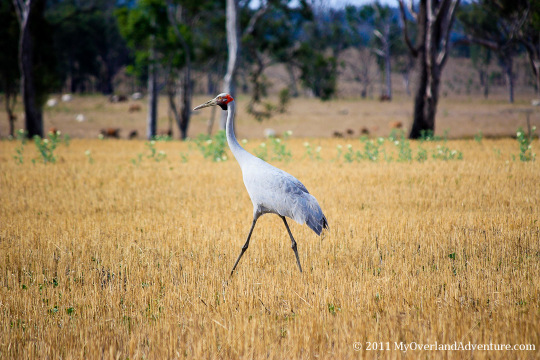
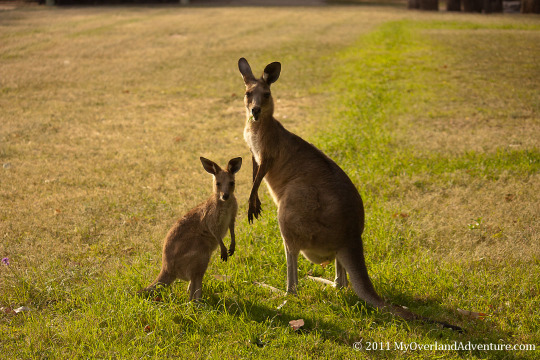
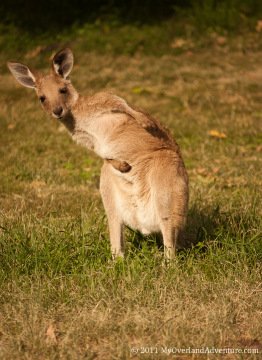
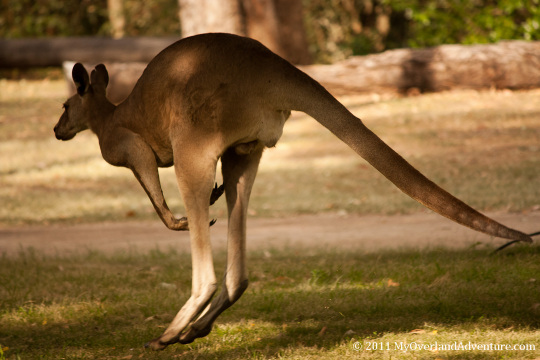
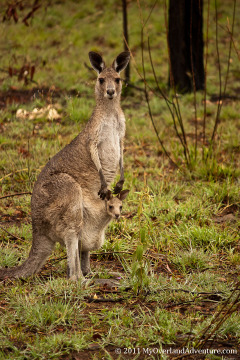
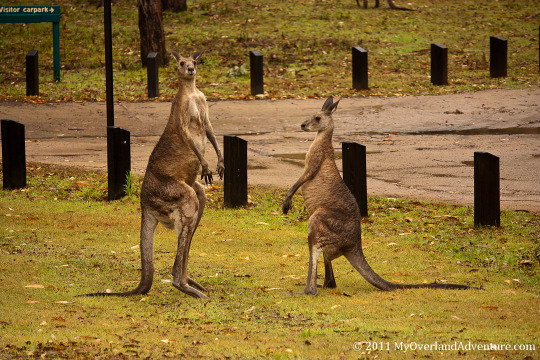
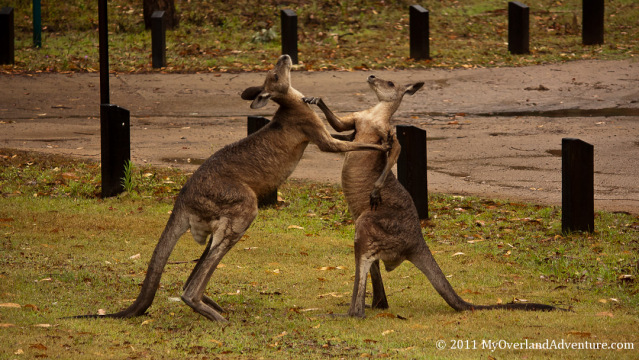
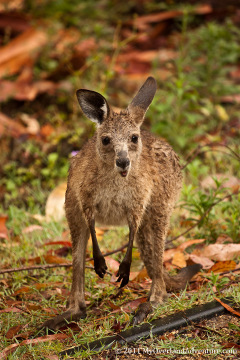
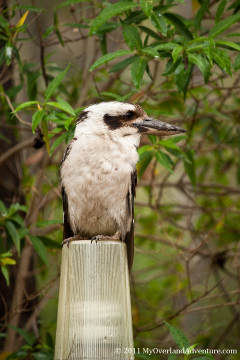
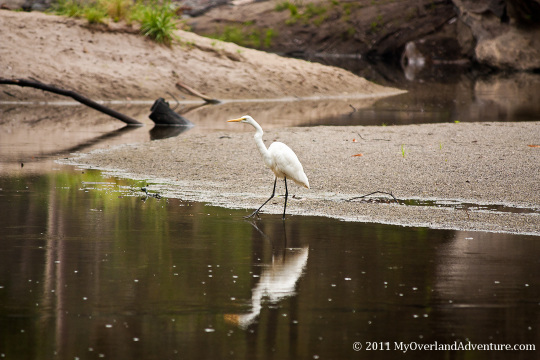
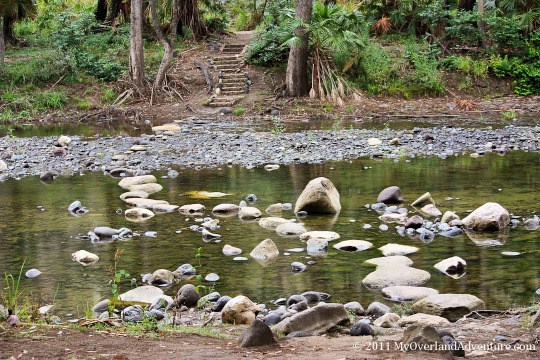
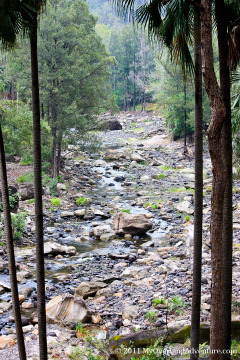
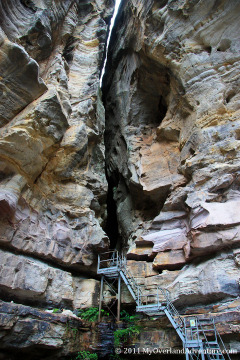
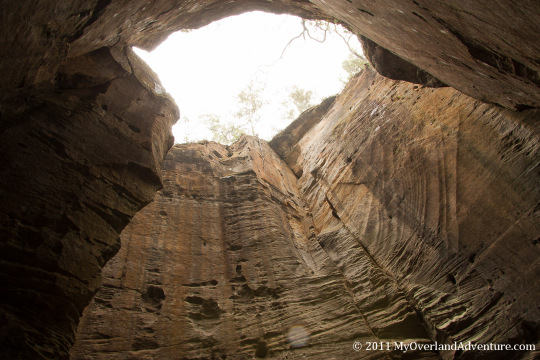
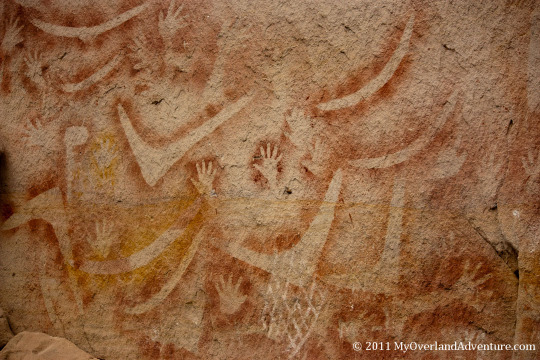
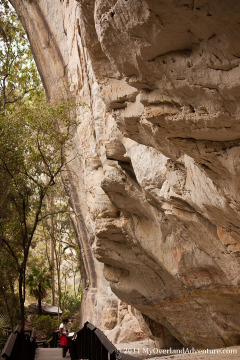
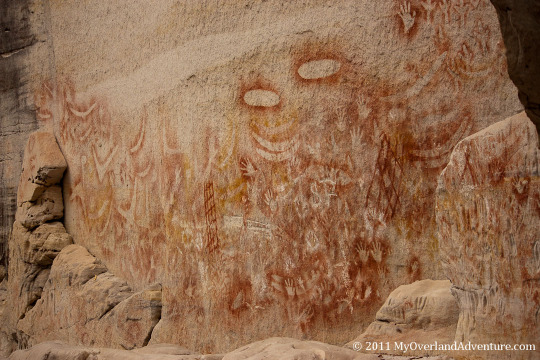
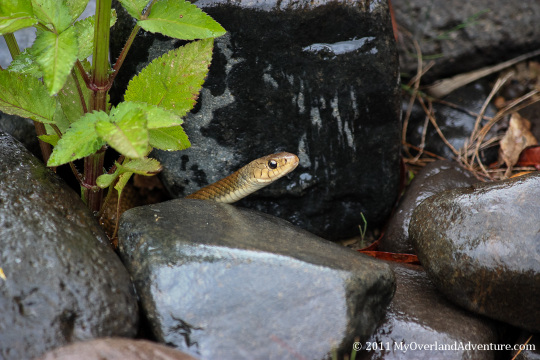
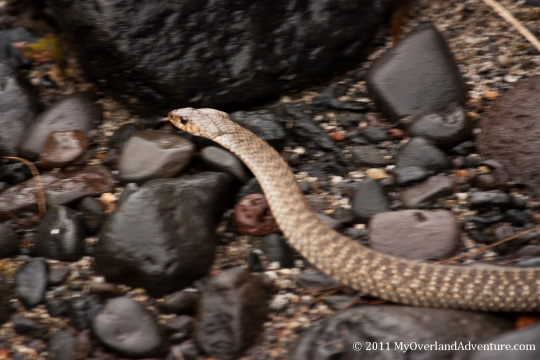

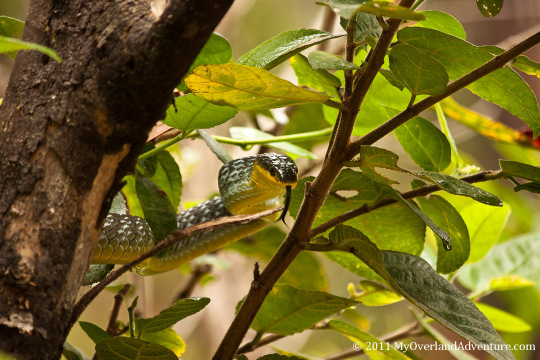
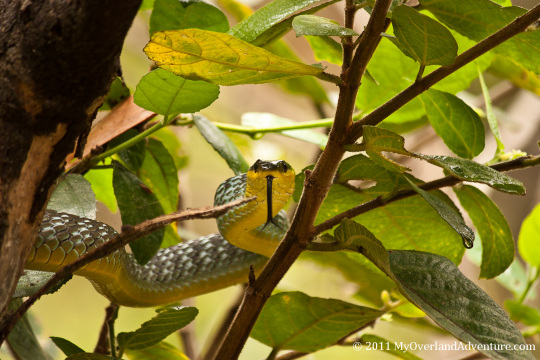
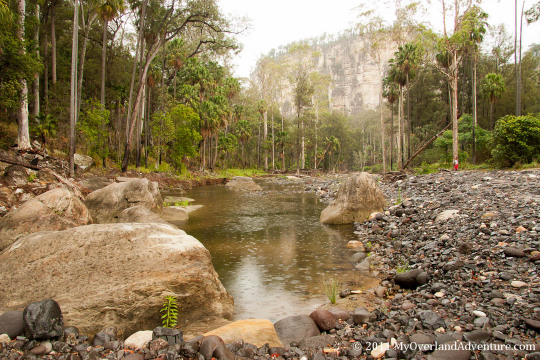
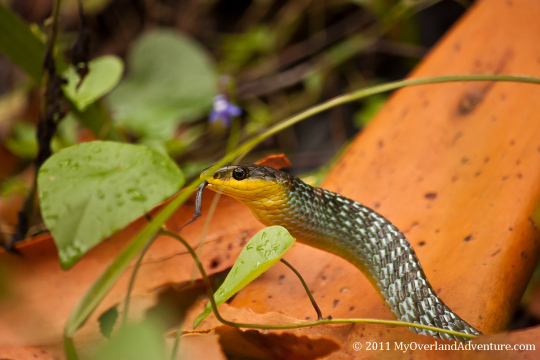

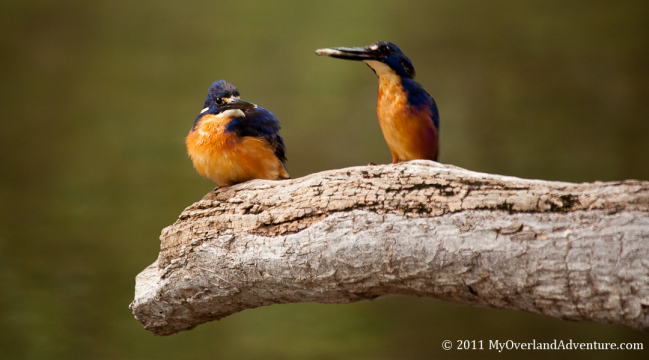
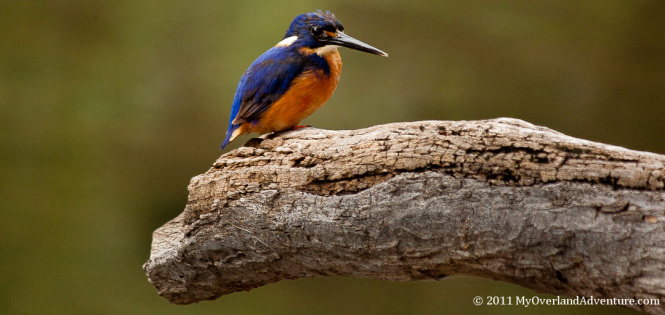







Fantastic photos!! 🙂 I just moved to Australia this year and although I have kangaroos hopping through my backyard regularly, I’ve never been able to get close enough to photograph them. So glad you guys did! 🙂